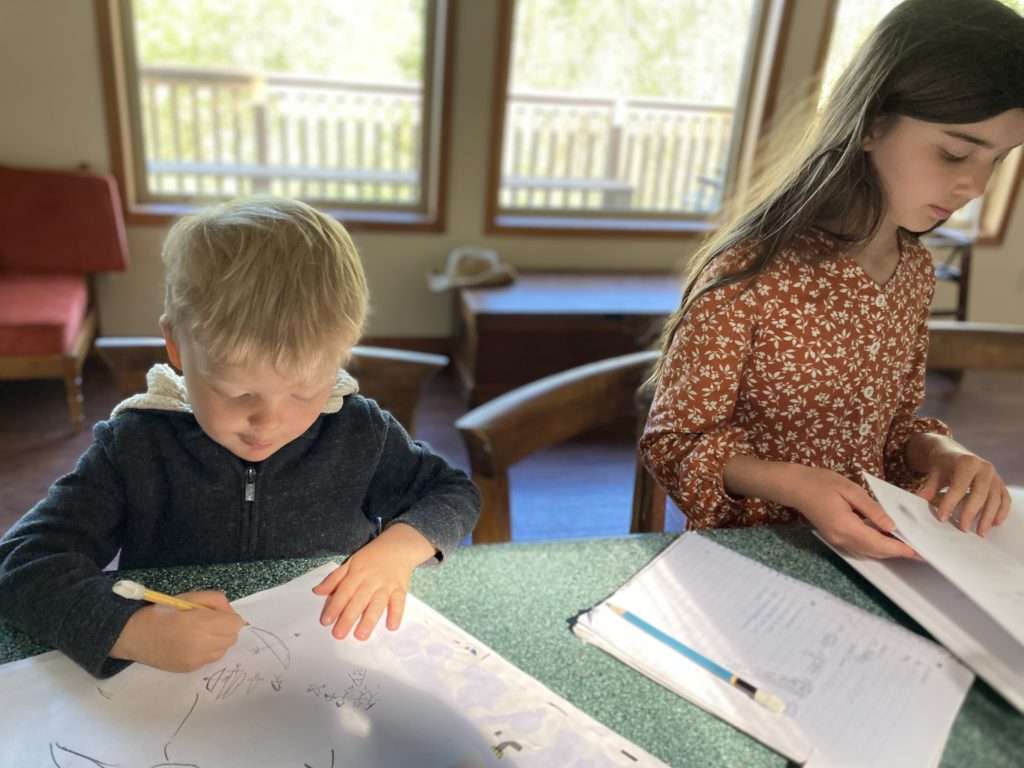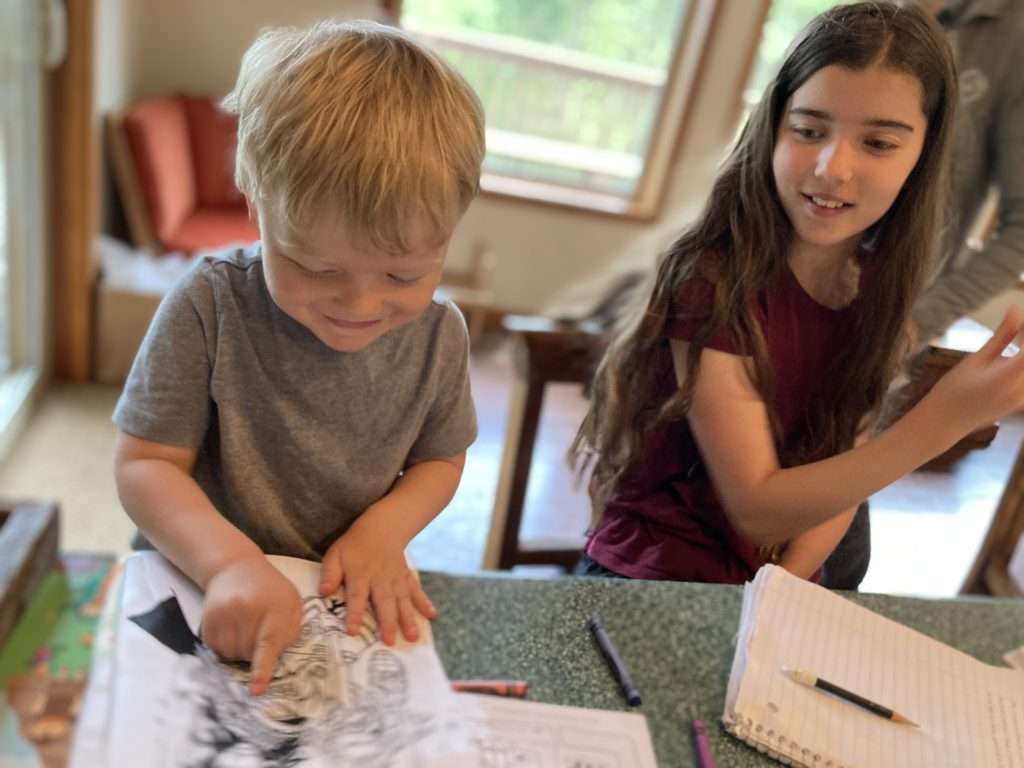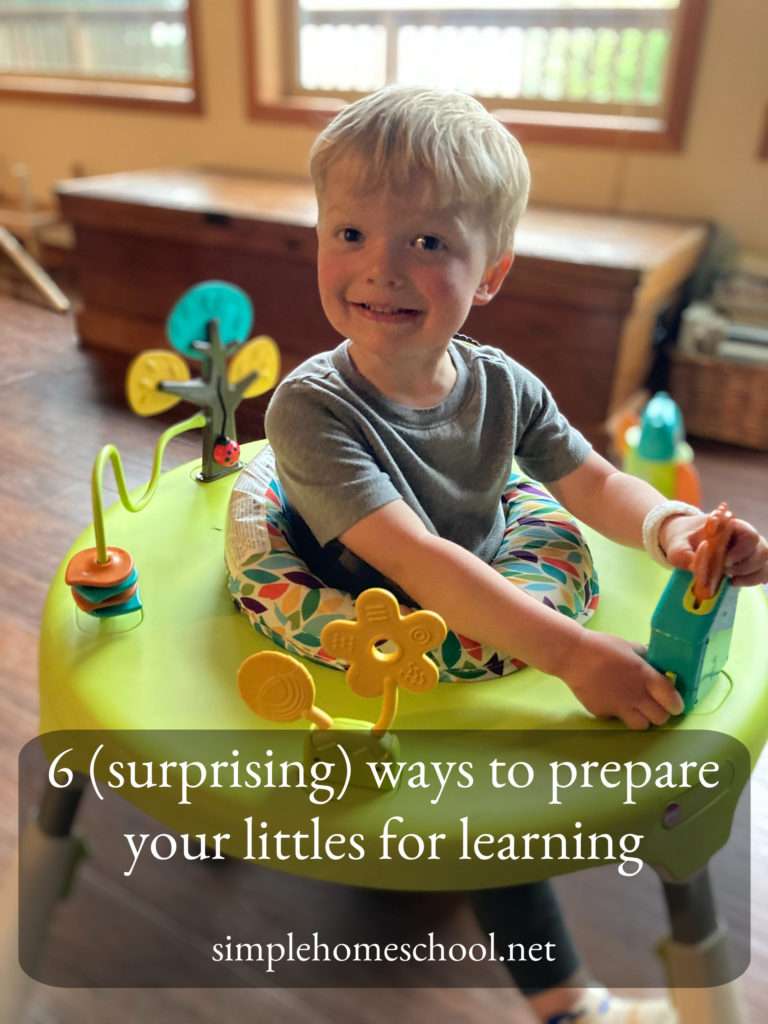6 (surprising) ways to prepare your littles for learning ~
Written by Kari Patterson of Sacred Mundane
My current stage–juggling a baby and a toddler along with a teen and tween–has its challenges, to be sure, but one great aspect is the daily reminder of this important concept:
Begin with the end in mind.
It’s one of Stephen Covey’s seven habits, and can be applied widely. Grand scale: The Psalmist’s prayer: “Teach us to number our days that we may gain a heart of wisdom.” Envisioning what it will be like at the end of our lives (and after!) certainly helps bring perspective.
Prefer to listen instead?
But on a smaller scale, through the lens of education, these words can give us extraordinary insight into how we teach and train our toddlers, in order to set them up for successful learning later in life.
Having a 14-year-old helps me connect the dots: This toddler behavior becomes this teen behavior.
The first time around, I focused primarily on preparing my preschoolers academically. Counting. Letters. Colors. All good stuff.
But now, more than a decade later, I think these six things stand out as preschool essentials!
6 (surprising) ways to prepare your littles for learning
1. Self-control
Ways to teach it young: Little ones can’t comprehend abstract concepts, but this one small practice can help immensely: Teaching our toddlers to clasp their hands together and hold them in their lap. In our house we say, “Get self-control,” and this cues the clasped hands. It gives them something to do to get their bodies under control, rather than just focusing on what they aren’t supposed to do.
What it looks like later: What a gift to a teen and tween when they have already developed a healthy measure of self-control! Rather than relying on outward rules and regulations, they’ve learned (to some extent) to govern their time, appetites, and decisions. Even our 12-year-old daughter, when she’s having a particularly emotional and difficult day, will clasp her hands and remind herself to “get self-control” in order to stay calm. It might sound silly, but it helps!
2. Initiative
Ways to teach it young: Of course we aren’t expecting our two-year-olds to notice needs around the house, but we can intentionally ask them questions and encourage them to take initiative. If something is spilled: “What should we do to clean that up so it doesn’t get yucky?” Or, “The kitty is hungry, what should we do about that?” Or, “We can’t eat dinner until the table is set, what could you do to help make that happen?” This is another reason to relax a bit and not push our children toward academics too young. What a joy to have a young child begging to learn to read rather than us forcing them before they’re ready.
What it looks like later: Ultimately, we want our children to take responsibility for their own education. They won’t really learn something unless they want to, until they’re motivated. Students who sit back and expect someone else to “educate them” probably won’t flourish in life. As I type these words Heidi is working through a Creative Writing curriculum she picked up on her own, because she wants to improve her writing. I never told her to do it, she took the initiative. She’ll grow because she wants to!

3. Memorization that matters
Ways to teach it young: We all know young children are masters of memorization. There are a lot of great things to memorize. I started pretty hard-core with certain memory work, but soon simply focused on memorizing Scripture. We did “Letter Lessons” — each week we’d learn about a letter that stood for a character trait (A — attentive, B — brave, C — compassionate). We’d learn about the character trait and memorize a verse that went with it. We had fun with it — rewording verses to rhyme or saying them with a certain cadence, with hand-motions.
What it looks like later: I’m amazed how these verses have “stuck” with us. To this day we’ll find ourselves saying a verse the way we memorized it when the kids were small. Of course we’re all going to have different educational priorities, but we decided to skip the prepositions in favor of the Proverbs. Begin with the end in mind just means we think very intentionally about what material will benefit our kids long-term.
4. Concrete Math
Ways to teach it young: Using manipulatives and, even better, real life materials to teach the concrete foundations of math will set our little ones up for success later on. Of course some math facts just need to be memorized, but nothing beats a little one comprehending concepts because she has actually seen them at work in the world.
What it looks like later: What a gift when older students can actually SEE math alive in their daily lives! Just today my 14-year-old was trying to convince his younger sister how valuable the math was that she was doing. Though she couldn’t see it, he could, because of his grasp on the ways these abstract concepts played out in daily life.
5. Excellence
Ways to teach it young: We have a children’s book called Halfway Herbert. It’s a hilarious story about a little boy who does everything only halfway. It’s fabulous! At every turn we have opportunities to teach our children to do a task with excellence, all the way, never half-heartedly, even if it’s something they don’t enjoy.
What it looks like later: Of course the ability to do things with excellence, even when you don’t want to, is HUGE later in life! We’re still working on this one as well (smile), but it’s worth the work.
6. How to ask for help
Ways to teach it young: I think every homeschool mom faces this at some point — a frustrated child who either won’t ask for help, or who too-frequently asks for help, or who over-reacts and cries. We see this in toddlers all the time. While they’re young this is the perfect opportunity to teach them to try their very best, but when faced with something they cannot figure out, to calmly (and without shame!) ask for help. Every time our children face an obstacle we have the opportunity to teach this process.
What it looks like later: I remember in college, hearing professors say that their office-hours were the most under-utilized resource on a college campus. Students would struggle, even flunk, but still not go in, in person, and ask for help. If a student has learned to take the initiative to calmly (and without shame!) ask for help, they will be lightyears ahead of so many! Some of us adults need to go back and relearn this as well.
How about you? I bet you have a wealth of wisdom on other ways to prepare your littles for learning. We’d love to hear!
What’s Your Homeschool Mom Personality? Take Jamie’s quiz now and receive a free personality report to help you organize your homeschool based on what your personality type needs most!




 Weekend homeschool links: April 30th
Weekend homeschool links: April 30th
So helpful! Thank you for these concrete ideas!
What a great article! This is so concrete and so inspiring in a really practical way! Thanks for joining some of the dots to those older years for us 😊
Love this, Kari!! I’ve more than once expressed my desire for homeschooling my children feels to me more like a responsibility to raise “good humans” than produce geniuses. I love the tips and practicality you flush out here — I’ll definitely be implementing some strategies this week. Thank you for sharing!
Kari, do you have a list of the character traits and scripture verses you used for your Letter Lessons that you would be willing to share? What a wonderful idea! Thank you!